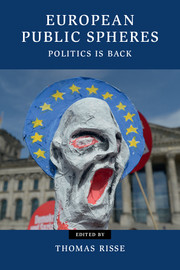Book contents
- Frontmatter
- Contents
- List of figures
- List of tables
- List of contributors
- Preface
- 1 Introduction
- Part I How to grasp the Europeanization of public spheres: theory, methods, empirics
- Part II Consequences: does the Europeanization of public spheres matter?
- Part III Theoretical and normative implications
- Bibliography
- Index
- References
Bibliography
Published online by Cambridge University Press: 05 November 2014
- Frontmatter
- Contents
- List of figures
- List of tables
- List of contributors
- Preface
- 1 Introduction
- Part I How to grasp the Europeanization of public spheres: theory, methods, empirics
- Part II Consequences: does the Europeanization of public spheres matter?
- Part III Theoretical and normative implications
- Bibliography
- Index
- References
- Type
- Chapter
- Information
- European Public SpheresPolitics Is Back, pp. 263 - 291Publisher: Cambridge University PressPrint publication year: 2014



